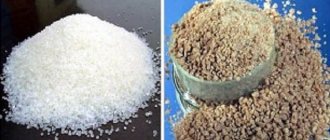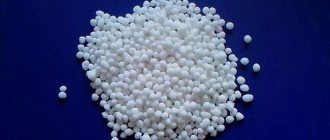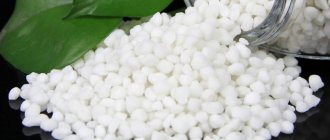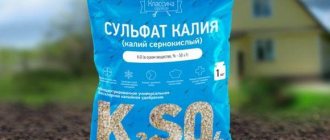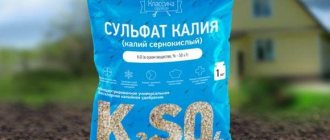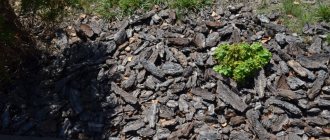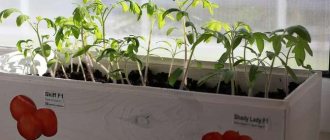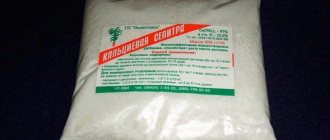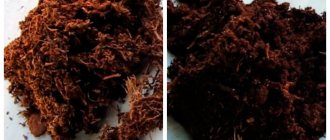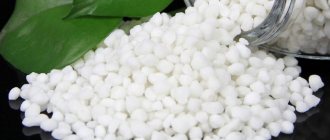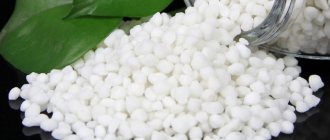Potassium sulfate is an inorganic substance, a potassium salt of sulfuric acid, also called potassium sulfate. It is used in many fields of activity: pharmaceuticals, cosmetology, food industry, and is also used as fertilizer in gardening and horticulture. The compound is a good chlorine-free fertilizer, which is used to replenish macronutrients during potassium starvation of plants. The substance has been assigned the food additive code E515; it is added to food products as a stabilizer and emulsifier, to extend shelf life and as a replacement for sodium chloride.
Description and composition of potassium sulfate
There are two types of potash fertilizers: chloride (potassium chloride, potassium salt) and sulfate (potassium sulfate, potassium magnesium, potassium nitrate).
Chloride fertilizers are used in the fall so that chlorine, which has a detrimental effect on plant growth, is washed out during the winter. Sulfuric acid fertilizers are obtained from natural minerals and do not contain chlorine, which has a negative effect on crops. Potassium sulfate is the best sulfuric acid fertilizer; it is a white crystalline powder with a grayish or yellowish tint. The fertilizer contains:
- potassium - 50%;
- sulfur - 18%;
- magnesium - 3%;
- calcium - 0.4%.
The ratio of other chemical elements is so small that they do not affect the effect of the fertilizer. The substance is highly soluble in water, which is ideal for spraying tree shoots and ornamental plants. The fertilizer does not have a tendency to deteriorate, therefore, during long-term storage it does not lose its quality, does not form lumps and does not lose its original appearance.
Obtaining potassium sulfate
Potassium sulfate as a chemical compound has been known since the beginning of the 14th century thanks to the chemists Boyle, Glauber and Tacheus.
In nature, potassium sulfate is found in deposits of potassium salts. In addition, it is present in the waters of salt lakes, however, in most cases, with various impurities. Pure potassium sulfate is relatively rare in nature. Its most famous natural source is the mineral arcanite in the form of white or transparent crystals, which is found in California (USA).
Potassium sulfate can be obtained from natural minerals that contain it. These include schenite, kainite, leonite, syngenite, glaserite, langbeinite and polyhalite.
In laboratory practice, reactions with potassium oxide, weak or unstable acids, and some others are used to produce potassium sulfate.
Chemical properties
From a chemistry perspective, the compound behaves like a typical average salt. It is characterized by the following reactions:
- Reacts with barium salts: BaCl2 + K2SO4 → 2KCl + BaSO4 (precipitate).
- Reacts with acids: K2SO4 + H2SO4 → 2KHSO4 (potassium hydrogen sulfate - acid salt).
- Reacts with sulfuric acid anhydride (sulfur gas - sulfur oxide with a valence of 6): K2SO4 + SO3 → K2S2O7 (potassium pyrosulfate).
- Participates in reduction reactions with the formation of potassium sulfide: K2SO4 + 4C → K2S + 4CO (carbon monoxide), the reaction is carried out at high temperature (900°C); K2SO4 + 4H2 → K2S + 4H2O - the interaction occurs at t = 600 °C and with the participation of a catalyst, which is red lead (trivalent iron oxide Fe2O3).
Note: the acidic residue SO4 (sulfate anion - not to be confused with CO4) is divalent, therefore, in order to correctly compile reaction equations, you need to take this point into account - the formula of potassium sulfate is written as K2SO4, not KSO4.
Getting a connection
Due to the fact that the substance is rare in nature, but is of great industrial importance, considerable attention has been paid to methods for obtaining K2SO4. The main production methods of synthesis involve carrying out exchange reactions of calcium chloride with sulfuric acid salts:
2KCl + 2MgSO4 → K2SO4 + 2MgCl2.
2KCl + Na2SO4 → K2SO4 + 2NaCl.
2KCl + FeSO4 → K2SO4 + FeCL2.
A chemically pure compound is obtained by treating solid chloride with sulfuric acid:
2KCl + H2SO4 → K2SO4 + HCl.
In laboratories they use slightly different methods to obtain the desired compound. The main ones:
There are quite a large number of reactions that will result in the formation of potassium sulfate (another name for the compound). The advantage of choosing one method or another will be the chemical purity of the resulting substance and economic feasibility.
Benefits of fertilizer
The main feature of the fertilizer is its acidity level - from 5.5 to 8 units. This allows you to improve the acid-base balance of any soil. Potassium sulfate also allows you to solve most problems associated with growing crops:
- Fertilizer significantly increases the content of sugars and vitamins in plant cells, increases plant resistance to diseases, and reduces the risk of fruit rot.
- Autumn feeding of plants allows you to withstand severe frosts without consequences for their life.
- The best option for crops that do not tolerate chlorine.
- Helps increase productivity by improving fluid circulation in plant cells, which ensures rapid distribution of nutrients (strengthens the root system and produces rich foliage).
- Spraying plants has a beneficial effect on the formation of shoots.
Crystal lattice:
| 300 | Crystal cell |
| 311 | Crystal grid #1 |
| 312 | Lattice structure |
| 313 | Lattice parameters |
| 314 | c/a ratio |
| 315 | Debye temperature |
| 316 | Name of space symmetry group |
| 317 | Symmetry space group number |
What soils is it suitable for?
The greatest need for potassium sulfide is experienced by acidified soils, the pH of which does not go beyond 5-8 units. The use of fertilizer gives a fairly good result in terms of normalizing the acid-base balance. In general, the type of substrate has a significant impact on the specific use of this fertilizer. Podzolic soils and peat bogs need it more than others. To a lesser extent - loams, since on them it simply does not penetrate into the fertile layer; in addition, potassium sulfide is not used for salt marshes.
Sandstones, peat bogs and floodplain soils - the use of this fertilizer on such soils greatly accelerates the growth of plantings, activates their vegetation in systemic directions and increases productivity. Loam, chernozem - in order for potassium sulphide to have the most effective effect on the growth of flowers and their fruiting, conditions of abundant moisture must be observed in these types of soils.
The feeding schedule and watering schedule should be drawn up as carefully as possible. For plants that grow on loam, leaf spraying is most often used; in-soil fertilizing is ineffective in this case.
Solonchak - this type of soil is rich in a wide variety of salts, so this soil simply does not require potassium sulfate. Limestone - this substrate is considered one of the most responsive and susceptible to agrochemicals. The fact is that it contains many potassium ions, which prevent this element from fully entering the tissues of agricultural plants in a form suitable for them.
We pay special attention to the fact that on lands with high acidity parameters, fertilizing with potassium sulphide is carried out only together with lime.
What plants don't like chlorine?
Chloride acidification is a process in which plants are unable to absorb water in the required quantities. The result is chlorosis of the leaves, in which they first turn pale, then turn yellow and crumble. Some plants are resistant to the effects of chlorine, but others are not able to feed and grow if potassium fertilizers with chlorine are constantly used - potassium chloride, ammonium, potassium salt.
Vegetables that do not like chlorine are cucumbers, root vegetables, tomatoes and various varieties of peppers. Chlorine fertilizers can disrupt the growth of garlic, radishes, radishes and all varieties of onions. Cabbage – all its types – categorically does not accept chlorine.
You cannot fertilize berry crops with chlorine fertilizers constantly. Although they are considered the cheapest, yield losses can be significant.
If, however, KCl was added by mistake, then the harmful effects can be neutralized with dolomite flour, magnesium salts, and charcoal. KCl is usually applied during digging in the fall so that the chlorine will disappear by spring.
Signs of deficiency and excess of potassium sulfate
A lack of fertilizer, as well as an excess, can harm plants and affect the quality of the harvest.
Potassium sulfate deficiency is determined by characteristic signs:
- The tips of leaves or tree tops begin to turn yellow and fade.
- The lower leaves become less vibrant, change color, or appear spotted.
- Shoots and stems lose their elasticity and break.
- The leaf size is much smaller than standard.
- Plant growth slows down and yield decreases.
- The taste of the fruit has changed.
If there is an excess of fertilizer, the plant undergoes the following changes:
- Young leaves become much thinner than normal, interveinal chlorosis appears (leaves change color, become discolored).
- The upper leaves become brown or brown in color, and the shoot dies.
- The lower leaves and shoots darken and curl.
- The length of internodes (the place where leaves are attached) is reduced.
- Damage to the root system occurs.
In order not to harm the crop being grown, it is necessary to take into account all the features that affect fertilizing (soil, plant type, fertilizing method, time of year) and follow the dosage of fertilizer specified in the instructions for use.
Structure and properties [edit]
Two crystal forms are known. Orthorhombic β-K2SO4 is the common form, but above 583 °C it converts to α-K2SO4. [7] These structures are complex, although the sulfate adopts a typical tetrahedral geometry. [8]
- Structure of β-K 2 SO 4.
- The coordination sphere of one of two types of K+ site.
- Environment SO4 in β-K 2 SO 4 .
Does not form a hydrate, unlike sodium sulfate. The salt crystallizes in the form of double hexagonal pyramids, classified as rhombic. They are transparent, very hard and have a bitter-salty taste. The salt is soluble in water, but insoluble in solutions of potassium hydroxide (sp. g. 1.35) or in absolute ethanol.
When potassium sulfate is heated in water and swirled in a beaker, the crystals form a spiral structure with several arms when allowed to settle. [9]
Deadlines for depositing
Potassium sulfate is used for feeding throughout the season - from early spring to late autumn.
- In heavy soil, it is better to apply fertilizer in the fall.
- Light soils are fertilized with sulfate in the spring during seasonal digging of the site.
- Plants are re-fertilized with potassium during their growth for full development.
- Fruit and berry bushes and trees are fertilized at the beginning of fruiting.
- Flowers are fed when the first buds open.
- Lawn grass - in early autumn.
Watch the video! Potassium sulfate
Natural resources
The mineral form of potassium sulfate, arcanite, is relatively rare. Natural resources potassium sulfate minerals are abundant in Stassfurt salt. This is the cocrystallization of potassium sulfate and magnesium calcium and sodium sulfates.
Relevant minerals:
- Cainite, KMg (SO4) Cl 3H2O
- Shenite (now known as picromerite), K2TAK4 MgSO4 6H2O
- Leonite, K2TAK4 MgSO4 4H2O
- Langbeinite, K2Mg2(TAK4)3
- Aphthalite (formerly known as glaserite), K3Na (SO4)2
- Polyhalite, K2TAK4 MgSO4 2CaSO4 2H2O
Potassium sulfate can be separated from some of these minerals, such as kainite, since the corresponding salt is less soluble in water.
Kieserite, MgSO4·Q2O, can be combined with potassium chloride solution to produce potassium sulfate.
Instructions for use
When using potassium sulfate for feeding garden and vegetable crops, you should adhere to the following recommendations. It is undesirable to overdose the active substance. Despite the harmlessness of the substance for humans, an excessive concentration of this salt in fruits can cause allergies and digestive disorders. In addition, it often spoils the taste.
It is very important to ensure complete delivery of the agrochemical to the root system . To do this, it is advisable to remove a layer of soil 10-20 cm thick before the autumn digging, add potassium sulphide and cover it with soil on top. Liquid solutions of potassium sulphide are poured into the ground through depressions made in the ground around the seedling, most often for this purpose they take the handle of a shovel, tilting it at an angle of 45 degrees so that the solution is as close as possible to the rhizome. If the substrate is light, then you can pour fertilizer directly under the root.
In mid-July, a second feeding is traditionally carried out; at this time, an aqueous solution would be the best option - it will work much better and at the same time faster, since it can easily penetrate to the peripheral roots. When planting fruit plants, potassium sulfide is added to the very bottom of the planting hole, preferably along with phosphate. From the moment you fertilize crops with this agrochemical until harvest, at least 2 weeks must pass.
Dry
In powdered or granular form, potassium sulfide is introduced into the ground immediately before planting, in some cases - along with planting. In addition, granules can be used in preparation for the winter season.
In liquid form
To prepare a nutrient solution, the crystals need to be diluted in water in strict accordance with the dosages indicated on the drug packaging, and then watered the seedlings. This method is considered the most effective, since it allows for maximum availability of microelements for the plant root system.
Spraying
The liquid solution is prepared based on the ratio of 40 g of granulate per 10 liters of water. After this, the green parts of the plant are treated with the resulting solution through a spray bottle. The volume of fertilizers should be diluted so that the entire supply is completely used, since it cannot be stored. In addition to potassium compounds, plants are often fed with other micro- and macroelements, so they need to be combined wisely. Gardeners should be aware of some nuances.
- It is forbidden to combine potassium sulphide with urea; their simultaneous use on the same crop area is not allowed.
- When introducing nitrogen and potassium compounds, they must be mixed in advance, even before the stage of introduction into the ground.
- On acidic soils, potassium sulfide is best used together with lime.
- The maximum effect can be achieved when using an agrochemical on carbonate soils.
Recommendations for individual garden crops
There are general ways to use potassium sulfate, but certain crops have special conditions for use:
Flower food
Potassium sulfate is applied as a fertilizer to all types of flowers in the open ground; it is also used to feed indoor crops. Chrysanthemums, daylilies, irises, petunias, gerberas, and callas are especially fond of this fertilizer. They respond well to fertilization with roses. When planting, place 80-100 g of dry matter in the holes and spill with water.
For foliar feeding, use a solution of 30 g of product and 10 liters of water. Water 1 sq. meter of land around the bush. In autumn and spring, fertilizer should be applied at the root, and in summer, foliar feeding should be carried out. This will help strengthen the immunity and frost resistance of flowers.
Potassium sulfate for tomatoes
For tomatoes, potassium sulfate is applied in the spring when digging an area of 1 square meter. meter 20 g of the drug. In summer, a fertilizer is used.
A solution of 10 liters of water and 1 tablespoon of the drug is used under the root. For spraying, 1 liter of water and 2 g of substance are used.
Root feeding is carried out 4 times per season:
- After planting the crop in the garden.
- Before the flower clusters appear.
- During flowering and the appearance of ovaries.
- At the moment of maturation. Complete fertilizing 2 weeks before harvest.
Combine foliar feeding with root watering. After the rain, you can feed outside the plan. In a greenhouse, feed the plants more often, but use less fertilizer.
Berry bushes
They are fertilized with potassium at the beginning of flowering. Around the trunk circle, fertilizer is applied to the soil at a rate of 20 g per 1 square meter. m. Raspberries, currants and hawthorn respond best to such feeding.
Cabbage and greens
Granules of the drug are applied during digging of the site and when preparing it for sowing seeds at the rate of 25-30 g per 1 sq.m.
Fruit trees
One tree consumes 200-250 g of potassium sulfate. Dry fertilizer is applied during planting in the hole. Subsequently, a liquid solution is used to water the tree trunk. Advice! When using dry granulate, it must be buried in the ground.
Beets, carrots and other root vegetables
For all vegetable root crops, potassium sulfate is added at the rate of 30 g per 1 sq.m.
Feeding cucumbers
Potassium fertilizers for cucumbers will have an effect only if nitrogen and phosphorus are applied in a timely manner. When the leaves acquire a bluish tint and begin to curl, the first fruits turn out to be deformed, and the plants need potassium.
You can feed cucumbers at the root with a solution of 10 liters of water and 2-3 tablespoons of granules. This will be especially effective on light soils. On loams it is better to spray the plants, use 1.5 tablespoons of the substance per 10 liters of water.
Grape
Vineyards are fertilized with potassium sulfate three times per season. The culture does not tolerate chlorine well, so potassium sulfate is used. Fertilizer must be produced every year, since grapes absorb a lot of this element.
For foliar feeding, 20 g of product are used per square meter of vineyard. The procedure is carried out on a cloudy day, after moistening the leaves.
The required amount of the product is diluted in 10 liters of water and 40 g of superphosphate is added to the solution. Do this in advance, since the last component is very difficult to dissolve.
Fertilizer for strawberries
Potassium sulfate is a readily available fertilizer for strawberries. To feed strawberries, dilute 1 teaspoon of potassium sulfate in 10 liters of water. You can water 20 berry bushes with this solution.
The crops need to be fed in May, before they begin to bloom.
Potato
In dry form, potassium sulfate is added to the soil while digging the site at the rate of 30-35 g per 1 sq.m.
Potassium sulfate for seedlings
To eliminate potassium starvation of seedlings, use fertilizers that do not contain chlorine. One of them is potassium sulfate. Feed the seedlings for the first time when 2-3 leaves appear. Apply a solution of 8 g of the substance and 10 liters of water. Apply fertilizer a second time a week after picking the sprouts.
Recommendations
- Patnaik, Pradyot (2002). Handbook of Inorganic Chemicals
. McGraw-Hill. ISBN 978-0-07-049439-8. - Windholtz, M; Budavari, S, eds. (1983). Merck index
. Rahway, NJ: Merck & Co. - Chambers, Michael. "Potassium sulfate RN: 7778-80-5." ChemIDplus
. US National Library of Medicine. - De Milt, Clara (1942). "Christopher Glaser." Journal of Chemical Education
.
19
(2): 53. doi:10.1021/ed019p53. - van Klooster, H.S. (1959). "Three centuries of Rochelle salt." Journal of Chemical Education
.
36
(7): 314. doi:10.1021/ed036p314. - ^ a b
Chambers, Ephraim, ed.
(1728). "Arcanum duplicatum". Cyclopædia, or Universal Dictionary of the Arts and Sciences
.
1
(1st ed.). James and John Knapton, etc. * 125. - ^ a b
Schultz, H.;
Bauer, G.; Schachl, E.; Hagedorn, F.; Schmittinger, P. (2005). "Potassium compounds." Ullman Encyclopedia of Industrial Chemistry
. Weinheim: Wiley-VCH. Doi:10.1002/14356007.a22_039. ISBN 3527306730. - Gaultier, M.; Pannetier, G. (1968). "Structure of the crystal form" Basse température "potassium sulfate K2TAK4-beta" [Crystal structure of the "low temperature" β-form of potassium sulfate]. Bulletin de la Société Chimique de France
(In French).
1
: 105–112. - Thomas, S. (2017). "Potassium sulfate, when dissolved in solution, forms a helical structure." Russian Journal of Physical Chemistry
B.
11
: 195–198. Doi:10.1134/S1990793117010328. S2CID 99162341. - United Nations Industrial Development Organization; International Fertilizer Development Center (1998). Fertilizer Manual
(3rd ed.). Dordrecht, The Netherlands: Kluwer Academic. ISBN 978-0-7923-5032-3. - "Super K (potassium sulfate)." American surface preparation. Archived from the original on December 9, 2014. Retrieved December 7, 2014.
Interaction with other fertilizers
Potassium is not mixed with urea and chalk. These beneficial substances should be added at different times in accordance with the instructions. When using manure or compost, potassium is not used because these fertilizers have sufficient nutrients. For use on acidic soil it must be mixed with lime. Potassium sulfate can be used simultaneously with phosphate fertilizers. For simultaneous use with nitrogen fertilizers, they should be mixed immediately before application.
When using potassium sulfate, we must not forget about the following precautions:
- Wear a mask, gloves and a respirator.
- In case of contact with exposed skin, rinse immediately with water.
- Do not breathe fumes.
Potassium sulfate is used for any crops growing in different soils. Fertilizer helps to increase yield, improve taste and preserve ripe fruits.
In order to avoid unexpected results, it should be used strictly in accordance with the instructions!
Indications for use on different soils
On peatlands, potassium sulfate is given preference over all other potash fertilizers. In the chernozem zone, it is used only for those crops that consume a lot of potassium compounds during the growing season, for example, sugar beets and pome fruits. Potatoes need potassium sulfate, but complex fertilizing with nitrogen and phosphorus is preferable.
Video: Useful tips for fertilizing
Soddy-podzolic soils are the least rich in potassium compounds. To cultivate the soil, it is necessary to apply it in the fall according to the instructions - every year the harvest will become richer.
On sandy soils, potassium sulfate does not remain within the horizon to which it was applied, so it is recommended to fertilize it more often in light soils. This is especially true in regions with high rainfall.
To the great joy of gardeners, the industry has created an alternative fertilizer that can replace potassium sulfate - humates. They make the sand more viscous and nutrients stay in the top layer longer.
Precautionary measures
Please note that applying excessive amounts of fertilizing does not benefit green spaces. An increase in the concentration of an element can be determined by the following symptoms:
- reduction in the thickness of leaf plates, the appearance of signs of chlorosis;
- coloring the upper part of the leaf brown;
- the appearance of fragments of dead tissue;
- destruction of the root system.
An excess of the element slows down the absorption of other useful substances by plants, so when fertilizing it is extremely important to adhere to the proportions specified by the manufacturer.
As you know, potassium sulfide is a fairly safe drug; in its pure form it can even be used in food. Still, it is a chemical substance, so when working with it you should follow standard safety rules:
- Before using the product, you need to protect your face and hands. This will prevent caustic splashes, vapors, and toxic dust from entering your eyes and respiratory system.
- If the compound gets on your skin or eyes, wash the affected areas as quickly as possible under running water and soap.
- If swelling, redness, severe itching and difficulty breathing occur, immediately take an antihistamine and seek emergency medical help.
Story
Potassium sulfate (K2TAK4) has been known since the beginning of the 14th century. It was studied by Glauber, Boyle, and Tachenius. In the 17th century it was called Arkanuni
or
sal duplicatum
, since it was a combination of an acidic salt with an alkaline table salt.
It was also known as caustic tartar
and
Glaser's Salt
or
sal polychrestum Glaseri
after pharmacist Christopher Glaser who prepared it and used it for medicinal purposes.[4][5]
Known as arcanum duplicatum
("double secret") or
panacea duplicata
in a pre-modern medicine, it was prepared from the residue (
caput mortuum
) left over from the production of Aqua Fortis (nitric acid, HNO3) from saltpeter (potassium nitrate, KNO3) and oil of vitriol (sulfuric acid, H2TAK4 ) through Glauber, process:
2 KNO3 + H2TAK4 → 2 HNO3 + K2TAK4
The residue was dissolved in hot water, filtered and evaporated to the cuticle. It was then left to crystallize. It was used as a diuretic and diaphoretic.[6]
According to Chambers Encyclopedia
, the recipe was purchased for five hundred thalers to Charles Frederick, Duke of Holstein-Gottorp. Schroeder, the Duke's physician, has beautifully described its use in hypochondriacal cases, continuous and intermittent fever, stone, scurvy, etc.[6]
Storage of K₂SO₄
The chemical is used not only in industrial farming, but also at home. It can be easily transported and stored as it does not contain explosive elements. Even though it contains sulfur, the substance is non-flammable, so it can be stored in a special container or in bulk.
The main thing is to protect potassium sulfate from dust and moisture.
Potassium sulfate is becoming more and more popular every year. It began to be used in gardening, vegetable gardening and even home floriculture. And it’s not surprising, since this is a very effective fertilizer at a low cost.
Watch the video! Potassium sulfate
Type of food additive, hazard and toxicity class, storage
Food additive E515 belongs to the class of stabilizers and emulsifiers. The substance belongs to hazard class 3 (moderately hazardous compound). This is because when pure potassium sulfate comes into contact with the skin, the crystals cause irritation, pain and burns.
Fertilizer is stored in ventilated areas away from direct sunlight and sources of heating. The optimal temperature range is from -35 °C to +30 °C. It is necessary to restrict access to the connection to children and animals. It should be stored in non-food containers, separate from medicines and food. The humidity level in the room should not exceed 60%. The shelf life is unlimited if storage conditions are met.
